Dustin Johnson: I can lower your golf scores
Published: Last updated:
Dustin Johnson and his team explain what you can learn from the Ryder Cup star and two-time Major champion to maximise your own potential, reduce your handicap and shoot your lowest ever golf scores.
There are few golfers with more natural ability than Dustin Johnson. But after he finished 2015 ranked eighth in the world, it was beginning to look as if he would fail to deliver on his incredibly potential.
Yet just 14 months later, DJ was US Open champion and World No.1. The TaylorMade staffer remains only the fifth golfer in history to retain that spot for a full year.
RELATED: Putting coach Phil Kenyon saves you six shots per round

Now, as the 2020 season draws to a close, Johnson has more than 100 weeks at the top of the ranking, with the FedExCup champion’s historic Masters victory (his second Major) taking him to 24 PGA Tour wins.
RELATED: WITB – Dustin Johnson’s clubs reviewed and tested
Here, with the help of his team, World No.1 DJ exclusively reveals the multi-faceted approach he used that allowed him to realise his potential and turn his career around.
You may not play golf at the elite level that Ryder Cup-star Johnson plies his trade, but that does not mean you cannot follow his example and get to the top of your game.
Whether that means winning the club championship, achieving a single-figure handicap, breaking 80, 90 or even 100, there is a challenge out there that is within the scope of your ability. And with the right approach, you can do. Just ask Dustin Johnson.
Lesson 1: Dustin Johnson on… Getting to the top
“I came out on tour in 2008. I managed to win in my rookie year on the PGA Tour, a feat I have repeated every year apart from 2014. But although I broke into the top 10 as early as 2011 and had some near misses at Majors, my game was largely treading water. I wasn’t achieving as much as I should have.
“But at the end of 2015, something changed. I think, looking back on it, I just got tired of being an OK golfer. I wanted to be better. At the end of the season, my team and I got together and focused on where I could improve. It was definitely my wedge game.
“My distance off the tee means I have an awful lot of wedge approaches… but I was fed up of having 80 yards in and leaving myself a 20ft putt. My Strokes Gained figure was 0.09, in other words right on the tour average. I did not find wedge practice exciting, so I rarely worked on them… or if I did, it was with no discipline.
RELATED: Me And My Golf’s best-ever tips

“I started working with launch monitor TrackMan on controlling distances. There was no secret to it; it was just repetition and hard work, hitting thousands of wedge shots.
“A few years ago, my former coach Butch Harmon said every other golfer in the top 10 outworked me. It was probably correct then; I doubt it is now. People have made a lot of the natural ability I have, but everything I have achieved in golf has been down to hard work.
“As my wedge performance improved, so did my results. Before the final round of the 2016 US Open at Oakmont, I spent 75 minutes hitting wedges. My win there took me into the top three in the world for the first time.”

Three things you can learn from Dustin Johnson’s journey to the top
➤ Make your weakness your strength. As DJ admits, it is human nature to overlook the parts of the game you’re not so good at. But real improvement comes when you target your weakness. To be sure of yours, collect your own stats or use individual shot-related data capture technology like MyRoundPro.
➤ Improve at the golf shot you need the most. DJ chose to work on wedges because of his prodigious distance off the tee, which meant he was often looking at a wedge approach. Understand what type of shots you need to hit most often, and working on them to improve your performance.
➤ To improve you have to change. To reach the top, DJ stepped up his discipline and work ethic. To break through your current level, make an extra, sustainable commitment to work on your game.
RELATED: Best Wedges
Insider View: David Winkle, Dustin Johnson’s manager, Hambric sports
“There was literally a moment in time where I saw the switch flip with Dustin. It was at the Northern Trust Open in February 2016. He was playing the Wednesday pro am. His team had won it, it was raining, and it was lunchtime. I was waiting in the clubhouse for him to come in and eat, but he did not appear.
“I went down to the range and there he was, hitting wedges in the rain. I knew there and then that things were different. I think his improvement was a combination of the maturing process we all go through in our 20s, and that quite simply he had reached a point where he realised he could perform at a much higher level. It was like he said ‘enough; I’m going to take these great gifts I have and make the most of them.’ And he did.”

Lesson 2: Dustin Johnson on… Making your best golf swing
“My dad was a golf pro. Sure, he would answer my questions when I asked them, but by and large he let me find my own way. I’m glad he did, because I am firm believer in individuality. Everyone is different. For me, the best way to improve is to figure out your own golf swing and then work out what works best for it. This is something I’ve done throughout my career.
“When I was learning the game, I decided I wanted to swing with a clubface that stayed square to the ball, rather than square to the plane of movement. It was simply the way I taught myself to be the most consistent, and I stuck with it because it worked. I guess it’s given me my trademark bowed left wrist. People tell me I play with a shut face, but I don’t think about it.”

“For me the golf swing is two-feet long, and that’s the 12 inches either side of the ball. All that really matters is the way it enters and exits impact. Everything else is style, and preference. Every year, I see kids coming out on tour who immediately change their games. Perhaps they feel they have to swing it like some photo fit Tour pro. But the upshot is they go away from what got them on tour in the first place. So they struggle, and the first year they may not keep their card. If they would only develop their own games, I’m sure their progress would be smoother and faster.
RELATED: Dustin Johnson – How you can create driver power
“Of course I do work on my game, but I am not very technical. I guess my two keys are ‘set-up’ and ‘repetition’. Your address position dictates the way the ball comes out, so I will constantly check and adjust mine. Then it is a case of hitting balls to train the shape or flight I am looking for. A great example was at the end of 2015, where I decided to change from draw to fade because I was finding it more consistent and my misses were tighter. All I changed was set-up – alignment and ball position. The rest takes care of itself.

“I like to play with no swing thoughts at all, and whatever I have on the day is what I’m going with. In my experience, many club golfers spend the round fighting their swings. Jack Nicklaus once said: “You have to dance with the lady you brought to the dance,” and that’s great advice if you’re going to get the most out of any day’s golf.”
Three things you can learn from Dustin Johnson’s golf swing
➤ Forget ‘orthodoxy’ and focus on impact conditions. As DJ says, getting them right is ultimately the only thing that matters. Book regular launch monitor sessions to help you.
➤ Basics are for winners, not beginners. Even at the top of the game, the address fundamentals like grip, aim, balance and posture hold the key to success. Monitor yours.
➤ Play your own game. The individual nature of golf makes copying someone else’s action a fruitless and frustrating task. Building your own action is the key to releasing your natural ability.
Insider View: Claude Harmon, Dustin Johnson’s swing coach
“DJ is a great example of how, when it comes to practice, quality trumps quantity. His practice sessions last from 90 minutes to two hours, and probably 80 per cent of his time is spent on wedges and short game. He’s not someone who stands there beating balls; he finds that boring, and when you are not engaged in what you are doing this is pretty much wasted time. But by having shorter, more focused range sessions he guarantees every ball he hits counts.

“He is more a feel player than a technical one. When he started working with my father Butch, they talked about the very bowed wrist and ‘shut’ face he has always played with. My dad was smart enough to leave it in place. “This is what makes you good,” he told DJ. “We could change it, but then no one’s going to know who you are.”
“History has shown us that trying to force orthodoxy on a feel player rarely works. DJ proves, as long as you put the club on the ball consistently well, there is plenty of room for latitude in technique.”
Lesson 3: Dustin Johnson on… Playing the mind game
“Prior to my 2016 US Open win, I think it was fair to say no one wanted to finish off a Major more than me. I had come close on many occasions. In 2010 I was leading the US Open by three and didn’t get it done.
“I also missed a play-off for the PGA through a last-hole penalty. In 2011 I was in the mix for The Open before knocking one OB on 14; then I three-putted the final green at Chambers Bay to lose the 2015 US Open.

“I guess I could have let those things affect me. If I had, I wouldn’t have become World No.1. Instead, I chose to see it that I must be really good to keep putting myself in those positions.
“That perspective definitely helped during that successful final round at Oakmont. When I first came out on Tour I spoke a little with a sports psychologist called Dr Mo Pickens, but I’ve not really felt the need for a mind coach.
“In college I let the game upset me, but I quickly realised that doesn’t help the next shot you are going to hit. I learned to differentiate between things you can control – your emotions, your reactions, the way you conduct yourself – and the things you can’t.
RELATED: Overcoming golf’s mind game myths
“I hit bad shots all the time, but you don’t see me get upset; I just don’t let it bother me. I try to take every situation whether it’s good and bad and take the positives out of it, what I can learn from it. I think that is the sign of a good athlete, and if you look at the top of any sport you will see similar traits.
“I appreciate this is something that is easy to say and not so easy to do, but I think I’ve proven I can do it. I’m not sure where the ability has come from, but I think the experience of playing and learning the game pushes you towards this perspective.

“Golf is a game where you lose a lot more than you win. It’s also all on you, nobody else. If you don’t like that you better not be a golfer. But I enjoy those elements of the game, and I think that when you do it becomes easier to bring a more beneficial attitude to your game.”
Three things you can learn from Dustin Johnson’s mental game
➤ Just missing out on victory could be taken as a sign of choking or of failure. It could also be taken as proof that you are getting closer to success. Like DJ, choose the healthier, latter option.
➤ Accept inconsistency. DJ knows he will hit some rank bad shots, and because of this acceptance he is more prepared to deal with them when they crop up. When you take this on board, you will become a tougher, more resilient golfer.
➤ Redefine failure. In a game where we lose a lot more than we win, it’s easy to get negative about ourselves. DJ avoids this trap by taking perhaps the healthiest attitude possible to failure. Where there are lessons to be learned, learn them. If not, forget about it. Easier said than done perhaps, but certainly a goal to pursue.
RELATED: Why trying harder makes you play worse golf
Insider View: David Winkle, Dustin Johnson’s manager, Hambric sports
“One of the best things about DJ’s 2016 US Open win was how he coped with the potential penalty for causing the ball to move in his final round. The grace with which he dealt with it caused people to reflect and perhaps recall how he handled the penalty for grounding his club at the 2010 US PGA, or his last-green three-putt at the 2015 US Open; he went straight to (eventual winner) Jordan Spieth and shook his hand.
“I’ve been in golf management for 32 years and the game all my life, and I have never seen anyone with a mind like DJ. He just doesn’t get angry or frustrated. I have never seen him swear or slam a club. I tell him he was coated in Teflon at birth – everything just rolls right off him.

“He also has this uncanny ability to remember positive things and let go of the bad times, while learning from them. At the 2010 US Open he was leading by three on Saturday night before shooting 82. He said: ‘That probably bothered me till the next day.’ In 2017 at the WGC at Shanghai he finished with a 77.
“‘Golf is funny,’ he said. ‘It really doesn’t matter what you did yesterday.’ There are people who get angry because their flights are delayed, or because they are stuck in traffic. That’s not DJ. While the rest of us are blowing fuses, he never wastes one second of his time or energy worrying about something that is beyond his control. He probably has the best attitude of any golfer out there.”
Lesson 4: Dustin Johnson on… Setting up your golf bag
It is important for any golfer to have equipment they feel they can rely on. For me, that means consistency of selection, and this is one reason why I’ve been with TaylorMade ever since I turned pro in 2007. The other reason, of course, is that they come up with great new models year after year.

“I am a gear nerd and I love trying new clubs… but I hate switching them. My policy is to build my TaylorMade bag at the start of the year and then keep it the same throughout the season, only switching in or out if a course or conditions require it. You shoulkd do the same.
“During the FedExCup Playoffs I carried the same equipment throughout, putting a TaylorMade SIM Max 7-wood with 21° of loft into my bag to complement my SIM Max 3-wood (15°).
RELATED: Best Fairway Woods
“I alternate between the 7-wood, a SIM Max 5-wood (18°) and SIM Max Rescue (18°) depending on the course.
“This year the staples in my bag have been my TaylorMade SIM driver (10.5°), P730 irons (3-PW), Milled Grind Wedges in 52º and 60º and my TP5X golf ball.

“I’m a big fan of TaylorMade Spider putters. My trusty Spider Tour IB Limited has been performing so well and I now have 12 victories using it. I only missed one putt inside five feet during the The Northern Trust and BMW combined (104/105).”
RELATED: Best Putters
Three things you can learn from Dustin Johnson’s golf bag set-up
➤ Consistent club selection breeds reliability, confidence and trust. Change clubs only when you are convinced of a preference or performance benefit.
➤ Test before you put into play. DJ gives all new equipment a thorough trial before making a decision on it. You should, too.
➤ Driver spin is key. A driver that gives the optimal spin for your power and launch is essential if you are to reach your distance potential. Book a launch monitor lesson with a pro to assess this.
Golf lesson 5: Dustin Johnson on… Getting fit for golf
“I have always stayed fit, but in recent years my gym work has become an increasingly important part of my game. I try to go every day, but in reality I average five-six days a week. This work has been instrumental in getting me to World No.1.
RELATED: The key move all good golfers make
“For me, the gym is as much about the mind as the body. It helps me feel strong, feel good about myself and boosts my confidence; it’s good to feel you’re training harder than the guy you’re up against.
“But also, when you’re fitter you are less fatigued. That means you can feel as alert on the 18th tee as you did on the first, an undervalued key to playing winning golf. Whether I’m playing 18 or 36 holes, I never feel tired.

“Typically, I’ll start on the bike for 20-30 minutes. Then I will move into whatever we are doing that day. Usually that falls into chest and biceps, back and triceps, or legs and shoulders; it’s a complete body system that involves plenty of golf-specific activities. I am naturally flexible, so my stretching work is more about maintenance than creation. I have never had any back issues… unless you count the time I fell down the stairs on the eve of the 2017 Masters.
RELATED: Longest Driver
“Working out has one extra benefit for me – it allows me to hit the ball further without losing control. I’m probably hitting the ball no harder than 85-90% maximum, and still averaging 314 yards on the PGA Tour. This is a big reason why I was ranked 1st in Strokes Gained: driving.”

Three things you can learn from Dustin Johnson’s golf fitness regime
➤ Gym work can be as beneficial to the mind as it is to the body. In giving you extra confidence and endurance, it can give you the edge on your opponent.
➤ Improving your strength can deliver extra power, but it also allows you to swing more within yourself, adding control without losing any power.
➤ If you want to start regular golf-related gym training, seek out an expert in the field. They will be able to guide you towards the most appropriate activities, devise routines and help with injury avoidance.
Insider View: Joey Diovisalvi, Dustin Johnson’s golf fitness coach
“When I work with DJ, we use things that have been around for years, but repackaged to benefit a professional golfer. The golfer needs power from the ground up, the ability to create a balanced sequence, the ability to rotate. Our work is all based on these needs and could involve everything and anything, including high intensity routines, endurance, cardiovascular training, strength and power work. To this end we had:
Core days: We might usebalancing sequences with band loads, such as archer pose, or recreate the swing sequence with dumbbells, arms spread wide. Anything that encourages the core to maintain and contain range of motion and balance, width and control.

Power days: This includes things like Olympic lifts, anything that trains the mechanics of thrust and velocity. To rotate at peak speed, a golfer needs the ability to thrust with explosive dynamics.
Conditioning days: This includes things like bike work and jumping up on to surfaces.
Balance days: This is jumping and turning routines, cone drills to boost awareness of a balanced sequence – basically anything to challenge your body’s ability to load and rotate with poise.
READ NEXT: How Dustin Johnson influenced TaylorMade’s new irons
-
 Dustin Johnson became just the third player to win five points at the Ryder Cup.
Dustin Johnson became just the third player to win five points at the Ryder Cup.
-
 Dustin Johnson with coach Claude Harmon.
Dustin Johnson with coach Claude Harmon.
-
 Dustin Johnson is one of the longest hitters on tour.
Dustin Johnson is one of the longest hitters on tour.
-
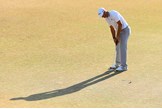 Heartbreak for DJ at Chambers Bay.
Heartbreak for DJ at Chambers Bay.
-
 Dustin Johnson wins the 2016 US Open at Oakmont.
Dustin Johnson wins the 2016 US Open at Oakmont.
-
 Address position is key for Dustin Johnson.
Address position is key for Dustin Johnson.
-
 Dustin Johnson rarely changes his equipment during a season.
Dustin Johnson rarely changes his equipment during a season.
-
 Dustin Johnson's trademark bowed left wrist.
Dustin Johnson's trademark bowed left wrist.
-
 Dustin Johnson wins the Tour Championship and FedExCup.
Dustin Johnson wins the Tour Championship and FedExCup.
-
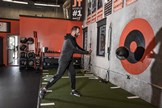 Dustin Johnson works hard on his fitness.
Dustin Johnson works hard on his fitness.
-
 Dustin Johnson and manager David Winkle.
Dustin Johnson and manager David Winkle.
-
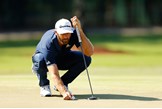 Dustin Johnson uses the TaylorMade Spider Tour IB Limited putter.
Dustin Johnson uses the TaylorMade Spider Tour IB Limited putter.
-
 Dustin Johnson doesn't let his emotions get the better of him.
Dustin Johnson doesn't let his emotions get the better of him.
-
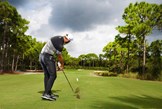 Dustin Johnson's wedge game is now one of his strengths.
Dustin Johnson's wedge game is now one of his strengths.
-
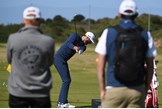
-
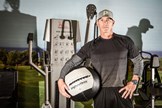 Joey Diovisalvi played a big role in DJ's fitness.
Joey Diovisalvi played a big role in DJ's fitness.
